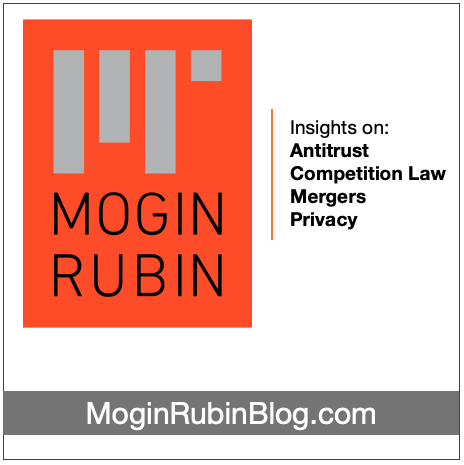REGISTRATION INCLUDES
Nearly 75 minutes of insights from experienced professionals.
CLE credit: 1+ (subject to bar rules).
For CLE questions: CLE@LitigationConference.com
The complete Power Point presentation.
Continued access to the complete recording for later use.
Answers to your questions via email to the presenters or write to HB and we will be sure to contact the speakers.
HB Litigation Conferences presents a CLE-eligible On Demand webinar
The Antitrust Case Against Google
Perspectives from highly regarded competition law attorneys, litigators, and economists.
This overview and Q&A has been developed for advertisers, mobile device makers, app developers,
corporate counsel, business writers, and search market participants.
 The U.S. Department of Justice and 11 states have filed a sweeping antitrust suit against Google alleging the tech giant abuses its position as “monopoly gatekeeper for the internet” to block competitors. The complaint says Google has used anticompetitive tactics to maintain and extend its monopolies in the markets for general search services, search advertising, and general search text advertising.
The U.S. Department of Justice and 11 states have filed a sweeping antitrust suit against Google alleging the tech giant abuses its position as “monopoly gatekeeper for the internet” to block competitors. The complaint says Google has used anticompetitive tactics to maintain and extend its monopolies in the markets for general search services, search advertising, and general search text advertising.
The federal and state governments charge Google uses “exclusionary agreements, including tying arrangements” to “lock up distribution channels and block rivals.” Google’s considerable wealth helps make this happen. Google pays billions of dollars a year to distributors to secure their position as the default search engine, and prohibits these companies from dealing with Google competitors. Google’s exclusionary strategy is being applied more harshly in newer technologies, such as voice assistants, and in its goal of dominating other platforms in the IoT category, such as smart speakers, home appliances, and autonomous cars.
Without a court order, the government plaintiffs say, “Google will continue executing its anticompetitive strategy, crippling the competitive process, reducing consumer choice, and stifling competition.”
What does all of this mean to actual or potential rivals, ad buyers, consumer, developers, and device makers in three markets Search Service, Search Advertising, and Search Text Advertising? What type of defense might Google mount? What might the ultimate resolution look like?
Join our panel, led by competition law thought leaders, as they address the potential impact of the litigation and answer your questions via live chat.
• Setting the stage: What constitutes an illegal monopoly?
• Lessons from United States v. Microsoft?
• How does the government define the three markets?
• What is in the alleged exclusionary agreements and tying arrangements?
• What does the government allege is improper about Google default settings?
• Why is requiring app bundles on devices considered improper in this case?
• Which companies is Google allegedly harming and how?
• What does Google’s immediate response tell us?
• Will private antitrust actions follow the government’s suit?
Meet the Speakers
Dan Mogin
Managing Partner
MoginRubin LLP

Read more about Dan Mogin or email him at DMogin@MoginRubin.com.
Jonathan Rubin
Partner
MoginRubin LLP

Read more about Jonathan Rubin or email him at JRubin@MoginRubin.com.
Jennifer M. Oliver
Partner
MoginRubin LLP

Read more about Jennifer Oliver or email her at JOliver@MoginRubin.com.
Timothy Z. LaComb
Associate
MoginRubin LLP

Read more about Tim LaComb or email him at TLaComb@MoginRubin.com.
Dr. Alan Grant
Associate Director
NERA Economic Consulting

Special thanks to
A few words about antitrust law.
Jennifer Oliver, an antitrust attorney and a certified privacy professional, kicked off the webinar with some background for those of you less familiar with antitrust. Here is a recap of what she had to say.
Section 7 of the Clayton Act prohibits mergers whose effect may be to substantially lessen competition or to tend to create a monopoly. Most Section 7 suits are filed by the government or private plaintiffs seeking to prevent damage to competition before the damage happens. While there is no allegation of violation of Section 7 in U.S. v. Google, many would argue that Google’s earlier acquisitions have harmed competition or quashed nascent competitors and should have been examined more closely.
The Sherman Act, part of which is implicated in the Google case, is more familiar to attorneys and businesspeople.
Section 2 of the Sherman Act, which is most relevant to U.S. v. Google, says you cannot monopolize or attempt to monopolize a line of interstate commerce through anti-competitive conduct. Contrary to a common misconception, monopolies are not per se illegal which, if you think about it, makes sense: If you invent a new product, you have 100% of the market for that product. Competitors will follow. But the fact of monopolizing a market is not in itself illegal. What is illegal is acquiring or maintaining that monopoly in a defined “relevant market” through anti-competitive conduct. Monopoly power is often measured in terms of the ability to control prices in the relevant market, or to exclude competitors in that market, which often means that smaller rivals can’t reach scale or can’t exercise any sort of price discipline over the monopolist.
How do we define the relevant market? That is an art onto itself in antitrust law, but you must define both product and geographic markets to successfully allege a monopoly exists. The concept of “product substitutes” is very important here, e.g., Would consumers be able to switch to another product if the alleged monopolist raised its prices or otherwise harmed consumers, for example through diminished quality or privacy?
Next we ask whether anticompetitive conduct was used to obtain a monopoly, and/or whether anticompetitive conduct is ongoing to maintain a monopoly. A monopolist may achieve its dominance illegally, while not maintaining its status through anticompetitive conduct, or vice versa. The relevant statutes are very broad and are open to judicial interpretation. Much of the conduct in modern monopolization cases occurs in new markets that didn’t exist when the laws were written. Internet search engines and digital advertising are perfect examples.
While anticompetitive conduct is not explicitly defined by Section 2 of the Sherman Act, caselaw offers examples, including exercising the power to engage in conduct that raises a rival’s costs and pricing below cost to drive rivals out of business.
These are key questions in U.S. v. Google. Does Google have monopoly power, has the relevant market been defined, and has it engaged in anticompetitive conduct? The panel discusses these issues and more.







